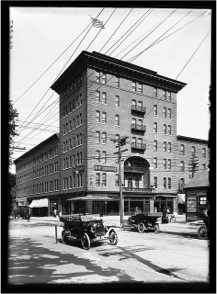
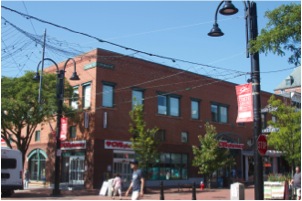
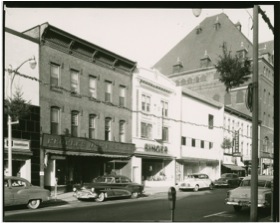
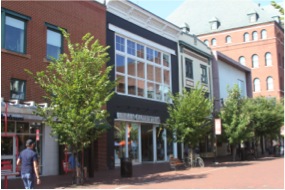
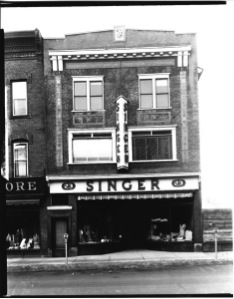
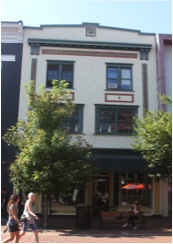
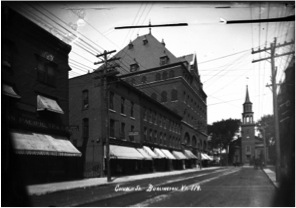
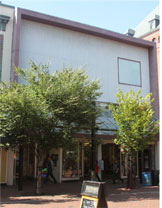
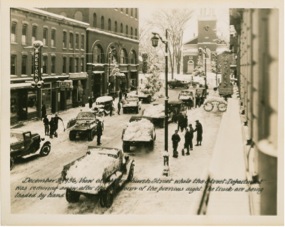
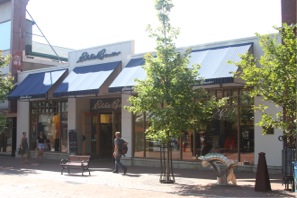
The story of the top block of Church Street is much like the story of Burlington as a whole. It is one of a growing city and the growing needs of that city. As Burlington grew so did the principle streets of the downtown, Church Street in particular. What was once an unassuming remote village became a booming and prosperous port city. Church Street mirrored these changes through the development of residential homes to brick commercial buildings and in the change in businesses that reflected the growing and changing needs of the city it served.
The historical research on five specific addresses shows how these locations represented the vicissitudes of Burlington from the early 19th century to present. I will attempt to explain how the changes in each location was a reflection on the change that the City was experiencing simultaneously. These specific changes will be explained though the alterations of architecture, the actual businesses themselves and the overall aesthetic of the streetscape. I will use maps, newspapers, directories, secondary histories, and images to describe these buildings and their occupants.
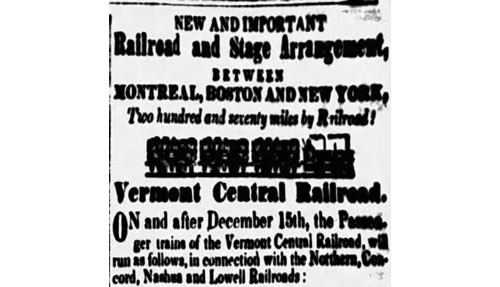
Before we can look at how Burlington grew it is important to first see why it grew. With a natural harbor on Lake Champlain, proximity to Montreal and the falls in on the Winooski River, Burlington was a prime location for economic advancement in a nation hungering for raw materials. The completion of the Champlain Canal in 1823 would link Burlington to New York City down the Hudson River and later the Erie Canal completed in 1825. In 1843 the Chambly Canal connected Burlington to the vast forests of Northern Quebec and the Street Lawrence River. Possibly the most significant change was the arrival of the Vermont Central Railroad in the winter of 1848 which linked Burlington with Boston and made the shipment of goods possible within a single day.1 These pivotal connections would lead Burlington into a new era as a hub of commerce. The buildings on the principle street in Burlington would mirror these changes.
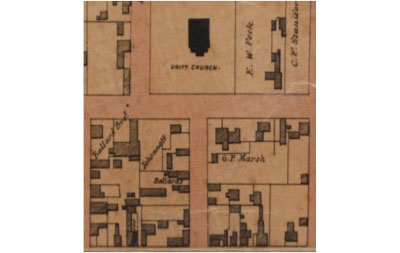
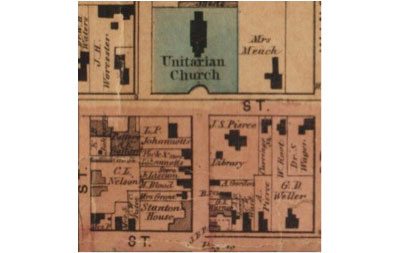
By looking at the growth shown on maps from this time period we can begin to see the development of the top block of Church Street changing from almost exclusively residential to predominately mixed us. In just sixteen years numerous shops and a hotel came to Church Street changing the feeling of the street to a more commercial neighborhood. In 1859, Henry Stanton would build a hotel on the corner of Church and Cherry Streets, believing that the combination of the location and his experiences would enable him to “offer a pleasant and acceptable home to his guests…”2 Two years later in 1861, Hiram Blood would purchase the dwelling just north of Stanton’s house and completely rebuild the structure so it could operate as a grocery store.3
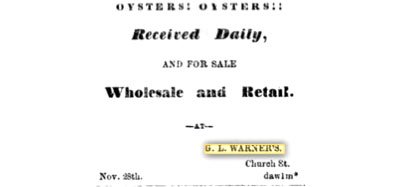
While Stanton’s House would have been the prominent building on Church Street, the construction of a new building at what is now 19 Church Street truly exemplified Burlington in the mid-19th century. On one end was S.S. Brown’s “China Hall” which was filled with cookery, flatware, glasses and various home goods. Next door was G.L. Warner’s grocery. Truly demonstrating Burlington’s new interconnected economy, Warner was advertising fresh oysters delivered daily along with tripe, macaroni, coffee, Canada salt and other specialties. Farther up the street was Mrs. Brown’s Bonnet and Millinery Shop, serving the women of Burlington imported fabrics. At the end of the new block was G.P. Wood’s Dry Goods and Carpets.4 Mr. Wood had become a prominent shop owner in Winooski but decided to sell that business and move to Burlington and try his luck on Church Street
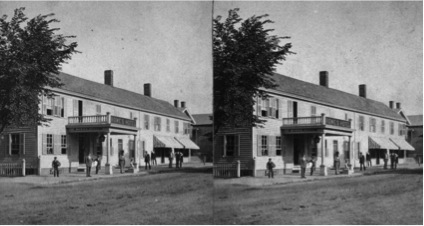
While the top of Church Street was growing and changing there was still evidence of a Mrs. Grant and subsequently a Mrs. Ann Williams living at 25 Church, between Stanton’s House and a grocery. As seen below, the Grant house would have been the gable-end building to the far right of the hotel and slightly stepped back from the street. Land records show that it was Mrs. Williams who sold the property to P.H Corley in 1885 who would build the three-story brick building that stands today.5 In true Victorian fashion, Corley sold a mixture of groceries, Catholic books and assorted stationary.6
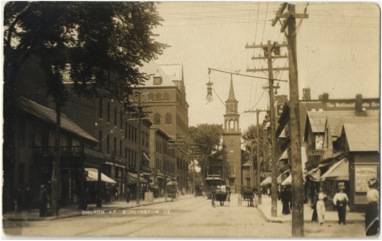
The history of the corner of Church and Cherry could be a separate story all on its own. While primary records are hard to come by, in W.S. Rann’s 1886 history of Chittenden County there is a brief note that an inn had been on the corner before the 1800’s which Rann believed was owned by Harvey Durkee. As for the building, the earliest depiction is Ammi Young’s hand drawn map from 1830 which does depict an ell-shaped building on the corner of Church and Cherry Streets.7 Newspaper articles only mention that Mr. Durkee was bankrupt and died at a young age. An article from 1876 does tell us that Harvey’s wife Dolly took over the business and that it was her that sold the property to Henry Stanton.8 Changing hands again in 1874, the new proprietor of the hotel, R.C. Rowe, would change the name to Rowe’s Hotel and shut down the business for three weeks for extensive repairs. While memorable, Rowe’s ownership of the hotel would prove short lived, selling the property in 1889 to G.M. Hopkins who briefly ran the business under the name Hotel Chittenden. Records show that the Chittenden like its predecessor Rowe’s was occupied by more locals than tourists, offering rooms for boarders and vagrants. Both hotels were mentioned frequently for police presence; gambling, unlicensed bars and illegal alcohol seem to be repeat offenses of hotel patrons.9
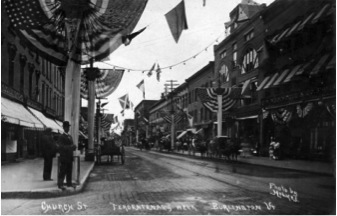
The switch from Hotel Chittenden to the Sherwood Hotel in the 1890’s happened as Burlington was at its economic peak. Following a fire in 1895 the Sherwood was completely rebuilt as a four-story brick building, anchoring the corner of Church and Cherry Streets. With the new structure, the urban streetscape of the top block was fully established, three-story brick buildings with large storefronts loomed over the cobblestone street and awnings advertised the businesses that offered shoppers provisions from all over the world. The trolley tracks added in 1885, were now running cars on electricity, carrying patrons all over the city and adding to the hustle of semi-urban life.10
If one were to leave the newly built Sherwood at the turn of the century and walk north on Church Street they would see shops that reflected Burlington’s prominence. On the ground floor of the hotel, E.H. Vancor sold electrical equipment; wires, call bells and other “electrics”. P.H. Corely’s store at 25-27 Church would become People’s Department store, selling all types of clothes and household needs. At 23 Church Street Union Pacific Tea Shop offered teas from faraway places. Hope Outfitters at 19-21 Church catered to both men and women, selling “made to wear” clothing and offering a new payment system that had proved very popular in large cities where the customer could put a small amount of money down and then pay off the rest later in the week. Upstairs from Hope’s was Gauvin’s Studio offering Kodak development and photographs.11
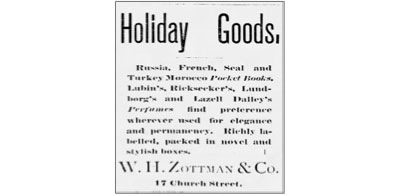
In 1885 a three-story brick building replaced the two-story wooden structure at 11-17 Church Street One of the first proprietors was furrier Henry Greene. Greene’s store sold everything from hides, skins, pelts, lime, hair and leather. Holding the position of volunteer fire chief, overseer of the poor and other prominent positions, Henry Greene’s store would have certainly been a popular place in Burlington.12 Prominent or not, Greene’s store would eventually fall victim to the constant change of Church Street, selling to W.H. Zottman at the start of the 20th century. Zottman’s pharmacy would occupy 17 Church Street for almost two decades and was known for compounding prescriptions having the best soda fountain in the state.13
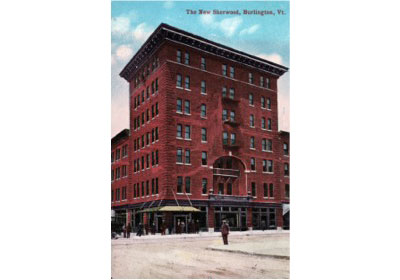
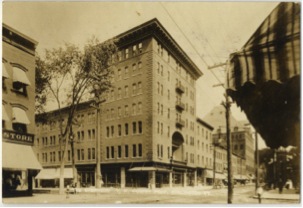
The shops south of the Masonic Temple on Church Street would have attracted both locals and visitors, no building would come to be identified with the top block of Church Street as did the New Sherwood Hotel. Completed in the summer of 1912, the seven-story hotel designed by Vermont architect Frank Lyman Austin featured various shops, a restaurant and even a “moving-picture hall” on the second floor.14 Widely documented, the New Sherwood was the subject of various postcards and photographs, speaking to its distinction and eminence. Stretching down Cherry Street, the New Sherwood was even home to P.T. Donovan’s car dealership. As early as April of 1914, Donovan was selling Oakland’s “the car with a conscience” and the 1915 Oldsmobile for only $1,285. The New Sherwood would host grand receptions and holiday banquets. The hotel would hold fashion shows from New York; boasting of furs from the finest select skunk, mink, Hudson seal, Belgian hare, tiger, civet cats and blue fox.15
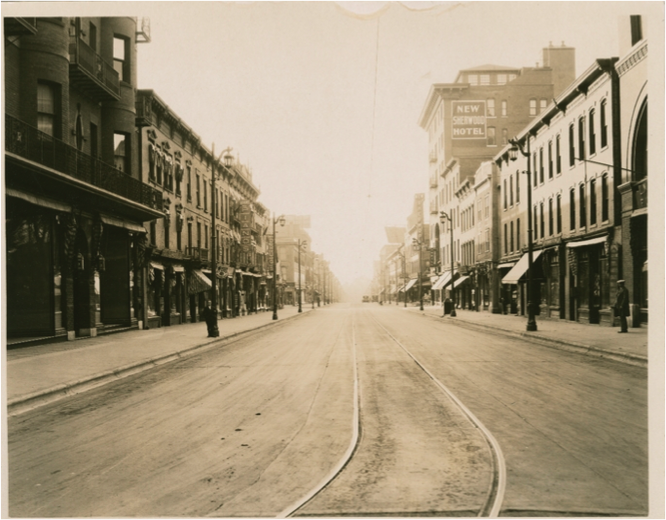
While the construction of the New Sherwood took place at the height of Burlington’s status it would also mark the peak. The grandness of the New Sherwood, the Masonic Temple and the Richardson building and the shops in between would never be matched by subsequent buildings. A series of fires and demolition would deteriorate the urban aesthetic of upper Church Street, leaving the past architecture a distant memory. The closing of the mills on the Winooski River in the 1950’s marked a new era for Burlington and the downtown that fed off its prosperity. Before the 20th century Burlington was experiencing whole-number percentage population increases every decade, after the turn of the century the city would fluctuate between growth and decline.16

As the future would prove, a city in this state would be unable to sustain the growth it had seen previously. With a few exceptions upper Church Street would only see minor improvements going into the 1920’s. Possibly the biggest change in architecture of this period was in 1926 when the owners of 23 Church Street renovated the façade of the old Italianate building to reflect the Art Deco style popular at the time. It was with this renovation that stucco was applied to the exterior and a tile crest was placed in the cornice. The arrival of Preston’s Jewelry store in 1917 to 17 Church Street would soon add the addition of a cantilevered sign over the street. White’s Pure Milk took over Union Pacific Tea in 1922 and offered shoppers and array of dairy products. Other renovations were taking place up the street at 11 Church Street when Harry White, no relation to the milk proprietor, took over the space next Preston’s Jewelry and added new, modern, windows to the front of his new sporting goods shop in 1933.17
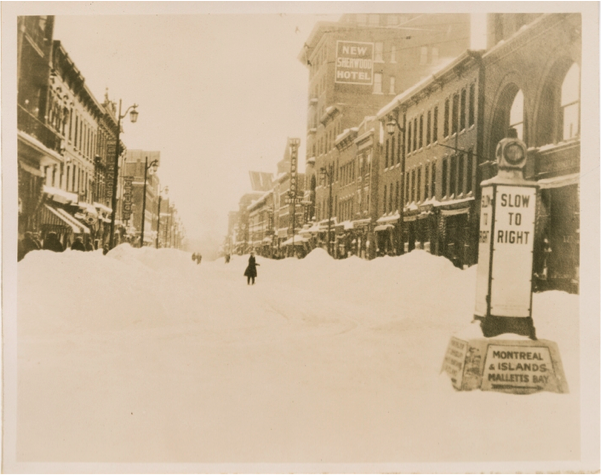
The addition of the Cheerio Grill and The Hub Cigar Store in the 1930’s to 19-21, and Federal Bake Shop to 11 Church Street in 1943 would coincide with a change in the anticipated customer to upper Church Street Once the locations to high fashion and imported goods were now a dairy shop, a bakery, two chain department stores and a jeweler. The intended customer switched from a visitor or tourist to a more local clientele. The destructive events in the 1940’s would only add to this change.
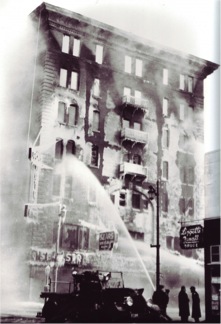
The Milner Hotel company would lease the New Sherwood Hotel in 1938 but their ownership would prove short lived. On Valentine’s Day 1940 a devastating fire ripped through the 29-35 Church Street leveling the seven-story building. The fire would completely wipe out the entire corner of Church and Cherry Streets. Stories of victims dangling by their fingertips in zero degree temperatures until reached by ladders gripped the entire city. Fifteen hoses poured almost instantly freezing water into the hotel saving all 160 patrons but ultimately unable to salvage the structure.18
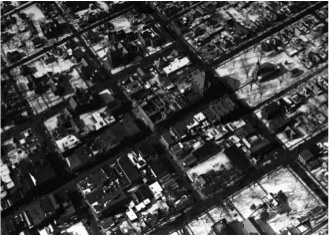
Following the fire, Sears and Roebuck would move to Shelburne, but would rebuild on their Church Street property in 1941. The new two-story, 16,000 square foot brick building would be occupied by J.C. Penny’s Department Store. A far cry from the grandeur of the New Sherwood, the new structure would end the nearly 100-year climb in elevation of upper Church Street and leave a void in the Burlington skyline. The large, white paneled siding covered the new structure would remain until J.C. Penny’s would leave the Church Street marketplace in the 1980’s.19
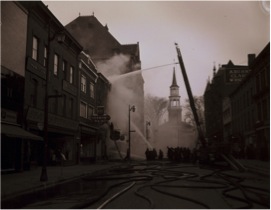
Unfortunately, the Milner fire was only the start of a series of destructive fires that would forever change the top block of Church Street Only five years later a small fire started in The Hub Cigar Store would grow to 4-alarm fire at 4 am on April 9th, 1945. Determining that the brick façade of 19 Church Street was in danger of collapsing on rescuers, firefighters would attach a winch to the top floor window then, anchored on an opposing streetlight, pull the façade down with the help of Burlington Public Works.20 The fire would leave a void in the streetscape of upper Church Street for years to come most likely because the nation was engaged with World War II. Finally, construction of a new building in 1953 would begin fill in the missing storefront left vacant almost a decade. The two-story Irving Building at 19-21 Church Street was constructed out of concrete with a flat roof. The large façade extends up from the roof another story. Corrugated metal siding is inset and encased by a large metal box floating above two recessed glass storefronts on the ground level. The first occupants would be Irving’s clothing store, showing the new building in advertisements to be as fashionable as the evening wear and bridal department.21
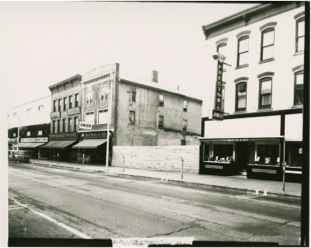
The third fire to forever alter the architecture of the top block of Church Street would again happen in the middle of winter in 1963. Journalists would describe the carnage left behind by the blaze as reminiscing of bombed out Europe during the Second World War. Despite the destruction of the roof and top floor of the building, F.J. Preston decided to open his jewelry shop for business the following morning, working under a temporary plastic tarp to keep the residual water out. The owner of 11-17 Church decided to save the ground floor of the original structure and simply remove the top floor; leaving a four-bay, one-story, flat roofed building. The current remains of the grand building that once house Henry Greene’s fur shop and Zottman’s Drugs is unrecognizable from its past glory.22
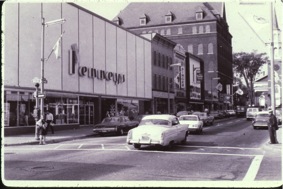
With this final conflagration in 1963 we are left with the current streetscape of upper Church Street Proprietors would come and go and some would make considerable alterations. Probably the most noticeable alteration after the fires was in 1972 with architect Benjamin Stein’s large glass wall design for Mayfair Department store at 25-27 Church Street that we see today. While the bracketed cornice of the Italianate building is original the structure and façade have gone under so many renovations that the building was deemed noncontributing to the National Historic District Nomination in 2010.23 The national bookstore chain Borders would completely renovate 29-35 Church Street in 1993, adding a large open staircase in the middle of the store, only to be removed by the subsequent occupant. Other minor alterations include the clothing chain Eddie Bauer adding a concrete façade and parapet to 11-17 Church that remain today.
With the exceptions of Tina’s Home Design (19-21 Church) and Burlington Violin Co. (23 Church) the rest of the stores are large chains, CVS Pharmacy, Urban Outfitters, Lulu Lemon, and Eddie Bauer. While the presence of chains on upper Church Street may seem like a new phenomenon, in reality it started back in 1895 with People’s Department Store. The true story of upper Church Street is change, changing store, changing appearances, changing aesthetic. The unrecognizable streetscape of today leaves little to no evidence of the past. The block that seemed to be perpetually pushing vertically now seems rather horizontal and low. Today the stores of upper Church Street are more inclined to serve a college town as opposed to a booming mill and lumber city, just as they changed from serving a small lakeside village in the mid 19th century. To say that the best days of Church Street are in the past misses the point that Church Street has constantly been transforming and shifting.
NOTES
1. “New and Important Railroad and Stage Arrangement,” Burlington Free Press (Burlington, VT), January 31, 1848.
2. “Stanton House,” Burlington Free Press (Burlington, VT), May 16, 1859.
3. “Buildings and Changes in Real Estate in Burlington,” Burlington Free Press (Burlington, VT) May 11, 1861.
4. “The New Block on Church Street,” Burlington Free Press, (Burlington, VT), November 06, 1863. Hiram Hart, Burlington City Directory and Business Advertiser. (Burlington: The Free Press Association,1865). 84.
5. National Register of Historic Places Nomination: Church Street Historic District, Chittenden County, Vermont. Burlington, VT: Vermont Division for Historic Preservation, 2010. 122.
6. W.S. Rann, ed. History of Chittenden County (Syracuse: D. Mason & Co., 1886), 480.
7. Ammi B. Young. Plan of Burlington Village. [Map]. 1830. “Historical Maps of Burlington and Winooski, Vermont”. Posted 8/12/2012. Accessed 10/20/2017 http://cdi.uvm.edu/collections/getCollection.xql?pid=burlingtonmaps
8. W.S. Rann, ed. History of Chittenden County (Syracuse: D. Mason & Co., 1886), 505. “Died” Burlington Free Press (Burlington, VT), February 20, 1874.
9. “The Weight of the Law: John Clark of Hotel Chittenden, Again Figures in Police Circles” Burlington Free Press (Burlington, VT), August 21, 1889.
10. Mark Bushnell, “Then Again: Vermont’s Love affair with the trolley” VTDIGGER, 12/4/2016 Accessed 10/20/17. https://vtdigger.org/2016/12/04/vermonts-love-affair-trolley/#.WeuUAEzMzUo
11. David Blow, Historical Guide to Burlington Neighborhoods (Burlington: Chittenden County Historical Society, 1991), 148. “E.H. Vancor” Burlington Free Press (Burlington, VT), January 18, 1898. “Kodak Work” Burlington Free Press (Burlington, VT), July 18, 1902. “Hope Outfitters,” Burlington Free Press (Burlington, VT), November 27, 1905.
12. Rann, 474
13. Rann, 480. “Holiday Goods,” Burlington Free Press (Burlington, VT) January 1, 1889.
14. National Register of Historic Places Nomination: Church Street Historic District, Chittenden County, Vermont. Burlington, VT: Vermont Division for Historic Preservation, 2010. 120
15. “Automobiles,” Burlington Free Press (Burlington, VT), April 15/30, 1914. “Furs for This Day Only” Burlington Free Press (Burlington, VT), October 23, 1915.
16. “Population of Burlington, VT,” Population.us, 2016, Accessed 10/19/2017. http://population.us/vt/burlington/
17. “Old Business Passes on Church Street as Brooks’ Cigar Store is bought Out by Harry L. White Co. Sporting Goods,” Burlington Free Press (Burlington, VT), September 02, 1933.
18. “Milner Hotel Property Destroyed…,” Burlington Free Press (Burlington, VT), February 15, 1940.
19. National Register of Historic Places Nomination: Church Street Historic District, Chittenden County, Vermont. Burlington, VT: Vermont Division for Historic Preservation, 2010. 120
20. “Business of 14 Upper Church Street Concerns Suspended by Fire,” Burlington Free Press (Burlington, VT), April 09, 1945.
21. “Irving’s New Fashions,” Burlington Free Press (Burlington, VT), February 25, 1954.
22. “Fire Cause Still Sought,” Burlington Free Press (Burlington, VT), January 31, 1963. Nancy Boone. National Register of Historic Places Nomination: Church Street Historic District, Chittenden County, Vermont. Burlington, VT: Vermont Division for Historic Preservation, 2010. Pg. 126
23. Ibid, 122
FIGURE SOURCES
Figure 1: “Vermont Central Railroad” Burlington Free Press (Burlington, VT) 1/31/1848
Figure 2: Presdee & Edwards. Map of Burlington, Vermont, 1853. [Map]. 1853. “Historical Maps of Burlington and Winooski, Vermont”. Posted 8/12/2012. Accessed 10/20/17
Figure 3: Worley & Bracher. Plan for the City of Burlington, Chittenden Co., Vt. [Map]. 1869. “Historical Maps of Burlington and Winooski, Vermont”. Posted 8/12/2012. Accessed 10/20/17
Figure 4: “Oysters, Oysters.” Burlington Free Press. (Burlington, VT) 11/30/1863
Figure 5: Old Rowe’s Hotel on Church. [stereograph] University of Vermont Special Collections, Wilbur Collection.
Figure 6: Upper Church Street Postcard. University of Vermont Special Collections, Wilbur Collection.
Figure 7: Photographer Unknown. Tercentennial 1909. Shelburne Museum Collections. Accessed at www.uvm.edu/landscape
Figure 8: “Zottman” Burlington Free Press (Burlington, VT) 12/20/1888
Figure 9: Hotel Sherwood- Burlington, VT Postcard, Burlington, VT. Bailey/Howe Library, Special Collections, Wilbur Collection, University of Vermont.
Figure 10: New Sherwood Hotel Postcard. Burlington, VT. Bailey/Howe Library, Special Collections, Wilbur Collection, University of Vermont.
Figure 11: Louis McAllister. Burlington Streets: Church Street. Louis L. McAllister Photographs, Box A4, Folder 04, Item 04. Accessed 9/17/17 http://cdi.uvm.edu/collections/item/mcalA04F04i04
Figure 12. Louis McAllister. Stores – Singer. Louis L. McAllister Photographs, Box B18, Folder 27, Item 01,. Accessed 9/19/17. http://cdi.uvm.edu/collections/item/mcalB18F27i01
Figure 13: Louis McAllister. Burlington Streets: Church Street. Louis L. McAllister Photographs, Box A4, Folder 04, Item 07. Accessed 9/18/17. http://cdi.uvm.edu/collections/item/mcalA04F04i07
Figure 14: Milner Hotel Fire, 4/15/1940 Postcard. Bailey/Howe Library, Special Collections, Wilbur Collection, University of Vermont.
Figure 15: Aerial Photograph. University of Vermont: Landscape Change Program. Accessed 9/19/17. http://www.uvm.edu/landscape/
Figure 16: 19-21 Church Street Fire, 4/9/1945. Accessed at http://www.uvm.edu/landscape/
Figure 17: Louis McAllister. Burlington - Street Views. Louis L. McAllister Photographs, Box B04, Folder 02, Item 13. Accessed 9/17/17. http://cdi.uvm.edu/collections/item/mcalB04F02i13
Figure 18: Church Street. University of Vermont Special Collections, Wilbur Collection.
Figure 19: New Sherwood Hotel, 1913. National American Buildings Survey.
Figure 20: Louis McAllister. Burlington - Street Views. Louis L. McAllister Photographs, Box B04, Folder 02, Item 14. Accessed 9/17/17 http://cdi.uvm.edu/collections/item/mcalB04F02i14
Figure 21: Frank Wagner. Unitarian Church at Head of Church Street. University Landscape Change Program. Accessed 9/19/17. http://www.uvm.edu/landscape/search/details.php?ls=17843&sequence=000&set_seq=421&imageSet=1508943546-59f0a6bade233&AddRel=0
Figure 22: Louis McAllister. Burlington Streets: Church Street, Louis L. McAllister Photographs, Box A4, Folder 04. Item #2. Accessed 9/19/17. http://cdi.uvm.edu/collections/item/mcalA04F04i02









